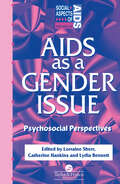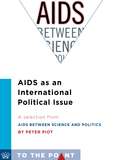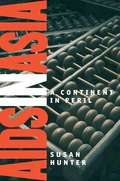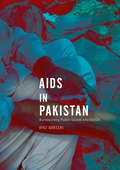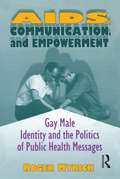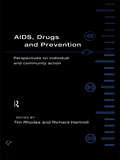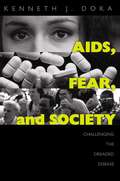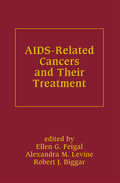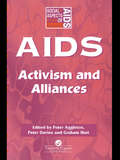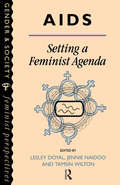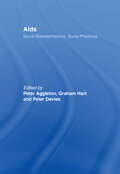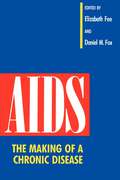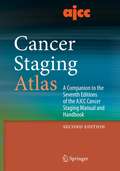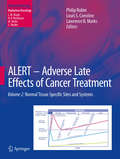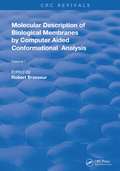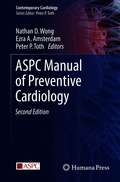- Table View
- List View
AIDS as a Gender Issue: Psychosocial Perspectives (Social Aspects of AIDS)
by Lydia Bennett Catherine Hankins Lorraine SherrThis international collection examines a wide range of psycho-social aspects of AIDS and HIV infection, including prevention, education, healthcare and policy in terms of gender challenges.
AIDS as an International Political Issue: A Selection from AIDS Between Science and Politics (To the Point)
by Peter PiotPeter Piot, founding executive director of the Joint United Nations Programme on HIV/AIDS (UNAIDS), reports on the influence of civil society in international relations and traditional partisan divides. AIDS thrust health into national and international politics where, he argues, it rightly belongs. The global reaction to AIDS over the past decade is the positive result of this partnership, showing what can be acheved when science, politics, and policy converge on the ground. Piot describes funding mechanisms for AIDS, the first international declarations, the response of the UN system, the establishment of UNAIDS, the response of high income countries to AIDS, The Global Fund and PEPFAR as game-changers, and lessons for other health problems.
AIDS in Asia
by Susan HunterAIDS in Asia provides a thorough introduction to the social and economic issues surrounding the AIDS epidemic in Asia including: * Geographic obstacles to health care* Gender inequality and human trafficking* Political turmoil and poor leadership* Asia's role in the sex and drug trade* Economic conditions and exploitation At the crucial moment when the spread of AIDS in this region is beginning to gain worldwide recognition, distinguished expert Susan Hunter makes clear the catastrophic threat AIDS poses to Asia and the world, and draws on her experience to discuss the potential policy implications.
AIDS in Pakistan: Bureaucracy, Public Goods and NGOs
by Ayaz QureshiThis book is the first full-length study of HIV/AIDS work in relation to government and NGOs. In the early 2000s, Pakistan's response to HIV/AIDS was scaled-up and declared an area of urgent intervention. This response was funded by international donors requiring prevention, care and support services to be contracted out to NGOs - a global policy considered particularly important in Pakistan where the high risk populations are criminalized by the state. Based on unparalleled ethnographic access to government bureaucracies and their dealings with NGOs, Qureshi examines how global policies were translated by local actors and how they responded to the evolving HIV/AIDS crisis. The book encourages readers to reconsider the orthodoxy of policies regarding public-private partnership by critiquing the resulting changes in the bureaucracy, civil society and public goods. It is a must-read for students, scholars and practitioners concerned with neoliberal agendas in global health and development.
AIDS, Communication, and Empowerment: Gay Male Identity and the Politics of Public Health Messages
by Roger MyrickAIDS, Communication, and Empowerment examines the cultural construction of gay men in light of discourse used in the media’s messages about HIV/AIDS--messages often represented as educational, scientific, and informational but which are, in fact, politically charged. The book offers a compelling and substantive look at the social consequences of communication about HIV/AIDS and the reasons for the successes and failures of contemporary health communication. This analysis is important because it provides a reading of health communication from a marginal perspective, one that has often been kept silent in mainstream academic research. AIDS, Communication, and Empowerment offers a critical, historical analysis of public health communication about HIV/AIDS; the ways this communication makes sense historically and culturally; and the implications such messages have for the marginal group which has been most stigmatized as a consequence of these messages. It covers such topics as: the relationship among gay identity, language, and power cultural studies of the historical development of gay identity studies in health communication about HIV/AIDS and health risk communication the political consequences of public health education about HIV/AIDS on gay men the political consequences of media representations of gay identity and its relationship to disease Based primarily on the French scholar Michel Foucault’s critical, historical analysis of discourse and sexuality, this book takes a timely and original approach which differs from traditional, quantitative communication studies. It examines the relationship between language and culture using a qualitative, cultural studies approach which places medicalization theories in the broader context of histories of sexuality, the discursive development of contemporary gay identity, and recent public health communication.Author Roger Myrick explains how mainstream communication about HIV/AIDS relentlessly stigmatizes and further marginalizes gay identity. He describes how national health education stigmatizes groups by associating them with images of disease and “otherness.” Even communication which originates from marginal groups, particularly those relying on federal funds, often participates in linking gay identities with disease. According to Myrick, government funding, while often necessary for the continuation of community-based health campaigns, poses obvious and direct restrictions on effective marginal education. AIDS, Communication, and Empowerment allows for a rethinking of ways marginal groups can take control of their own education on public health issues. As HIV/AIDS cases continue to rise dramatically among marginalized and disenfranchised groups, analysis of health communication directed toward them becomes crucial to their survival. This book provides valuable insights and information for scholars, professionals, readers interested in the relationship among language, power and marginal identity, and for classes in gay and lesbian studies, health communication, or political communication.
AIDS, Drugs and Prevention: Perspectives On Individual And Community Action
by Tim Rhodes Richard HartnollAIDS, Drugs and Prevention brings together a range of international contributions on the research, theory and practice of developing community-based HIV prevention. It aims to understand how individual actions to prevent HIV transmission are constrained and encouraged by situational and social context. Drawing on ethnographic and epidemiological research among populations of drug users, sex workers and gay men, it explores how future HIV prevention interventions can target changes at the level of the individual as well as at the level of the community and wider social environment. AIDS, Drugs and Prevention offers practical and theoretical insights into community-based health work in the time of AIDS. It provides invaluable reading for students, lecturers, researchers and practioners in health promotion, health policy, social work and medical sociology.
AIDS, Fear and Society: Challenging the Dreaded Disease (Death Education, Aging and Health Care)
by Kenneth J. DokaFirst Published in 1997. Routledge is an imprint of Taylor & Francis, an informa company.
AIDS-Related Cancers and Their Treatment
by Ellen G. Feigal Alexandra M. Levine Robert J. BiggarThis book summarizes the etiology, presentation, and treatment of the complex symptoms, infections, and opportunistic cancers of people living with HIV/AIDS.Presents therapies that strike a balance between controlling and eliminating cancer and minimizing the damage to the immune system.Illustrates points with clear and easily read figures,
AIDS: A Guide To The Law
by Richard Haigh Dai HarrisFirst published in 1995. Routledge is an imprint of Taylor & Francis, an informa company.
AIDS: Activism And Alliances (Social Aspects of AIDS #Vol. 10)
by Peter Davies Peter Aggleton Graham HartFrom the start of the AIDS epidemic there have been calls for greater solidarity between affected groups and communities, and public health services. This can be seen both in the move towards healthy alliances in health service work, and in the demands of AIDS activists worldwide. This text brings together specially selected papers addressing these and related themes given at the Eighth Conference on Social Aspects of AIDS held in London in late 1995. Among the issues examined are profession and policy; the heightened vulnerability of groups such as women and younger gay men; and issues of drug use, disability and HIV prevention.
AIDS: Foundations For The Future (Social Aspects of AIDS)
by Peter Davies Peter Aggleton Graham HartHIV and AIDS have posed new challenges to societies, communities and individuals. In many parts of the world, existing health and social services have been hard pressed to cope with the dermands of the epidemic. In hospitals and in the community, new approaches to health education, support and care have been developed. Non-governmental and community organizations have had a central role to play in responding to the challenge of HIV and AIDS. AIDS: Foundations for the Future highlights progress made over the last decade, and offers an agenda for future activism and research. This book examines the extent to which sound foundations for the future have been laid in public, private and voluntary sector action. It focuses on topics as diverse as workplace policy on HIV and AIDS, voluntary sector responses, the reactions of health care workers, the experience of living with AIDS, outreach work and community action, patterns of male prostitution, and new interventions to promote and maintain safer sex and safer drug use.
AIDS: Global Status 2010 edition
by Dr Stephen Berger Gideon InformaticsAIDS: Global Status is one in a series of GIDEON ebooks which summarize the status of individual infectious diseases, in every country of the world. Data are based on the GIDEON database (www.gideononline.com) which relies on standard text books, peer-review journals, Health Ministry reports and ProMED, supplemented by an ongoing search of the medical literature. Chapters are arranged alphabetically, by country name. Each section is divided into five subsections. 1. Descriptive epidemiology 2. Summary of clinical features 3. Global status of the disease 4. Status of the disease in a specific country 5. References
AIDS: Individual, Cultural And Policy Dimensions (Social Aspects of AIDS)
by Peter Davies Peter Aggleton Graham HartFirst Published in 1990. Routledge is an imprint of Taylor & Francis, an informa company.
AIDS: Responses, Interventions And Care (Social Aspects of AIDS #Vol. 4)
by Peter Davies Peter Aggleton Graham HartFirst published in 1991. Routledge is an imprint of Taylor & Francis, an informa company.
AIDS: Rights, Risk and Reason (Social Aspects of AIDS #Vol. 5)
by Peter Davies Peter Aggleton Graham HartFirst published in 1992. Routledge is an imprint of Taylor & Francis, an informa company.
AIDS: Setting A Feminist Agenda (Gender And Society Ser.)
by Jennie Naidoo Lesley Doyal Tamsin WiltonAIDS: Setting a Feminist Agenda" presents an overview of the important issues raised for feminist theory and practice by the HIV/AIDS epidemic, and outlines the direction in which feminist debates about the subject are developing. It makes essential links between feminism and HIV/AIDS work, and not only demonstrates that AIDS is a feminist issue, but also suggests areas where feminism is long overdue. The essays discuss medical issues; the specific social and political impact of HIV/AIDS on the lives of women of colour, lesbians, injecting drug users and prostitute women; And Current Health Educational And Health Promotional Practice As It relates to women.; The volume is theoretical and practical - suggesting theoretical models for understanding and challenging the social factors which are conducive to the spread of HIV among women and among men, as well as offering models of good practice for working with and for women.
AIDS: Social Representations, Social Practices (Social Aspects of AIDS #Vol. 2)
by Peter Davies Peter Aggleton Graham HartFirst Published in 1989. Routledge is an imprint of Taylor & Francis, an informa company.
AIDS: The Making of a Chronic Disease
by Daniel M. Fox Elizabeth FeeWhen AIDS was first recognized in 1981, most experts believed that it was a plague, a virulent unexpected disease. They thought AIDS, as a plague, would resemble the great epidemics of the past: it would be devastating but would soon subside, perhaps never to return. By the middle 1980s, however, it became increasingly clear that AIDS was a chronic infection, not a classic plague.In this follow-up to AIDS: The Burdens of History, editors Elizabeth Fee and Daniel M. Fox present essays that describe how AIDS has come to be regarded as a chronic disease. Representing diverse fields and professions, the twenty-three contributors to this work use historical methods to analyze politics and public policy, human rights issues, and the changing populations with HIV infection. They examine the federal government's testing of drugs for cancer and HIV, and show how the policy makers' choice of a specific historical model (chronic disease versus plague) affected their decisions. A powerful photo essay reveals the strengths of women from various backgrounds and lifestyles who are coping with HIV. A sensitive account of the complex relationships of the gay community to AIDS is included. Finally, several contributors provide a sampling of international perspectives on the impact of AIDS in other nations.
AIDS: Women, Drugs And Social Care (Social Aspects of AIDS #Vol. 1)
by Nicholas Dorn Sheila Henderson Nigel SouthExamines the circumstances, experiences and needs of HIV-positive people in Britain and Ireland, and particularly focuses on female drug-users and ex drug-users.
AJ Cronin Bestsellers: The Citadel, The Stars Look Down, The Keys of the Kingdom
by AJ CroninThree absorbing classics by the acclaimed Scottish novelist, including a National Book Award winner. This collection includes three novels whose settings range from Wales to China, and which paint a rich portrait of the changes and upheavals of the early decades of the twentieth century:The Citadel: Set in Great Britain in the years between the world wars, this National Book Award-winning novel is &“[a] fine, honest, and moving a study of a young doctor&” (The Atlantic Monthly).The Stars Look Down: This thought-provoking novel follows the challenges faced by a Northern England coal mining community and represents &“the finest work Cronin has given his public&” (Kirkus Reviews).The Keys of the Kingdom: A controversial Scottish Catholic priest embarks on a mission in China, where over years of hardship he learns the true meaning of humanity—and of faith—in &“a magnificent story of the great adventure of individual goodness&” (The New York Times Book Review).
AJCC Cancer Staging Atlas: A Companion to the Seventh Editions of the AJCC Cancer Staging Manual and Handbook
by Alexander Olawaiye Scott H. Kurtzman Julio Garcia-Aguilar David R. Byrd Carolyn C. Compton Mary Kay WashingtonSignificantly expanded, expertly and beautifully illustrated, The AJCC Cancer Staging Atlas, 2nd Edition, offers more than 600 illustrations created exclusively for this new edition and is fully updated to reflect the concepts discussed in the 7th Edition of both the AJCC Cancer Staging Manual and its companion Handbook. This Atlas illustrates the TNM classifications of all cancer sites and types included in the 7th Edition of the Manual and visually conceptualizes the TNM classifications and stage groupings. Specifically designed for simplicity and precision, the drawings have been verified through multi-disciplinary review to ensure accuracy and relevancy for clinical use. Every illustration provides detailed anatomic depictions to clarify critical structures and to allow the reader to instantly visualize the progressive extent of malignant disease. In addition, nodal maps are included for each site, appropriate labeling has been incorporated to identify significant anatomic structures, and each illustration is accompanied by an explanatory legend. The AJCC Cancer Staging Atlas, 2nd Edition, is an official publication of the American Joint Committee on Cancer, the recognized international leader in state-of-the-art information on cancer staging. This Atlas has been created as a companion to the updated 7th Edition of the AJCC Cancer Staging Manual, which continues to disseminate the importance of anatomical and pathological staging in the management of cancer. This state-of-the-art, invaluable 2nd Edition includes a CD containing PowerPoint slides of all illustrations, additional color, and a user-friendly, easy-to-read layout. The AJCC Cancer Staging Atlas, 2nd Edition will serve as an indispensable reference for clinicians, registrars, students, trainees, and patients.
ALERT - Adverse Late Effects of Cancer Treatment: Volume 2: Normal Tissue Specific Sites and Systems (Medical Radiology)
by Louis S. Constine Philip Rubin Lawrence B. MarksThe literature on the late effects of cancer treatment is widely scattered in different journals since all major organ systems are affected and management is based on a variety of medical and surgical treatments. The aim of "ALERT - Adverse Late Effects of Cancer Treatment" is to offer a coherent multidisciplinary approach to the care of cancer survivors. The Volume focuses on the general concepts and principles relevant to late effects and on the dynamic interplay of molecular, cytologic and histopathologic events that lead to altered physiologic and metabolic functions and their clinical manifestations. Chapters are also included on legal issues, economic aspects, nursing, psychological issues and quality of life. It is anticipated that this textbook will become the gold standard in providing information on the late effects of cancer treatment and that, in its digitized form, it will be referenced in cancer survivorship guidelines.
AMolecular Description of Biological Membrane Components by Computer Aided Conformational Analysis (Routledge Revivals #1)
by Robert BrasseurFirst published in 1990, the goal of these two volumes is to help fill the gap between theory and experiment in membrane science. Those involved with biochemistry, biophysics, pharmacology, and biology will find these volumes interesting and informative.
APLS compact: Spoedeisende Hulp bij Kinderen
by Nigel M. Turner Anneliese NusmeierDit boek biedt artsen en andere professionals een eenvoudige en effectieve methodiek voor de spoedeisende geneeskunde bij kinderen. Het helpt bij het zetten van de juiste eerste stappen bij de acute opvang van ernstig zieke of zwaargewonde kinderen. Informatie is visueel en tekstueel zo vormgegeven dat er snelle kennisoverdracht plaatsvindt.APLS compact is voor een groot deel afgeleid van het toonaangevende leerboek Advanced Paediatric Life Support: de Nederlandse editie. Het is een hulpmiddel bij acute situaties, zoals benauwdheid, shock, verminderd bewustzijn, convulsies, elektrolyten- en metabole stoornissen, traumaopvang en kindermishandeling. Het boek is specifiek voor de Nederlandse praktijk geschreven. Daarbij zijn landelijke richtlijnen en protocollen gebruikt, die gemaakt of onderschreven zijn door de Nederlandse wetenschappelijke verenigingen. U vindt in het boek verwijzingen naar websites met de meest actuele richtlijnen en adviezen. Ook krijgt u een inlogcode waarmee u het boek online kan raadplegen op bijvoorbeeld uw telefoon. APLS compact is geschreven door verschillende kinderartsen en -chirurgen. De hoofdredactie bestaat uit dr. Nigel Turner, kindercardioanesthesioloog in het Wilhelmina Kinderziekenhuis en onderwijskundige in het UMC Utrecht, en dr. Anneliese Nusmeier, kinderarts-intensivist in het Radboudumc Nijmegen.
ASPC Manual of Preventive Cardiology (Contemporary Cardiology)
by Peter P. Toth Nathan D. Wong Ezra A. AmsterdamThis second edition provides an updated review on the current guidelines and practice standards for the clinical management of cardiovascular risk factors and prevention of cardiovascular diseases. Endorsed by the American Society for Preventive Cardiology, this practical textbook includes concise descriptions of major and newer risk factors, biomarkers, and best practices in the management and prevention of cardiovascular disease. The manual contains chapters on the epidemiology and risk factors for a variety of cardiovascular diseases including dyslipidemia, hypertension, diabetes, inflammation, and ischemic stroke. It examines behavioral factors, psychosocial stress, family history, nutrition, physical activity, smoking, alcohol use, and other sociocultural factors. In addition, the book discusses new imaging strategies in detection of cardiovascular disease, prevention of heart failure, atrial fibrillation, and peripheral arterial disease, and prevention for special populations. Throughout the manual, recommendations are based on guidelines endorsed by the American College of Cardiology, American Heart Association, and other major societies. The second edition of the ASPC Manual of Preventive Cardiology is an essential resource for physicians, medical students, residents, fellows, nurses, and other healthcare professionals and researchers in cardiology, primary care, health promotion and disease prevention, exercise physiology, and pharmacotherapy.
